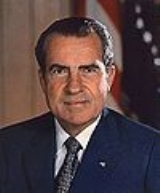
and senator
from California and as the 36th Vice President of the United States from 1953 to 1961 under President Dwight D. Eisenhower
.
Nixon was born in Yorba Linda
, California.
1952 Richard Nixon makes his "Checkers speech".
1958 During a visit to Caracas, Venezuela, Vice President Richard Nixon's car is attacked by anti-American demonstrators.
1959 At the opening of the American National Exhibition in Moscow, U.S. Vice President Richard Nixon and Soviet Premier Nikita Khrushchev have a "Kitchen Debate".
1968 United States presidential election, 1968: Republican Richard Nixon wins the American presidency, in what turned out to be a decades-long realignment election.
1969 Vietnam War: U.S. President Richard Nixon declares the Nixon Doctrine, stating that the United States now expects its Asian allies to take care of their own military defense. This is the start of the "Vietnamization" of the war.
1969 The ''Apollo 11'' astronauts are released from a three-week quarantine to enjoy a ticker-tape parade in New York. That evening, at a state dinner in Los Angeles, they are awarded the Presidential Medal of Freedom by U.S. President Richard Nixon.
1969 U.S. President Richard Nixon and Japanese Premier Eisaku Sato agree in Washington, D.C. on the return of Okinawa to Japanese control in 1972. Under the terms of the agreement, the U.S. is to retain its rights to bases on the island, but these are to be nuclear-free.
1970 President Richard Nixon signs the Public Health Cigarette Smoking Act into law, requiring the Surgeon General's warnings on tobacco products and banning cigarette advertisements on television and radio in the United States, starting on January 1, 1971.
1970 Protests erupt in Seattle, Washington, following the announcement by U.S. President Richard Nixon that U.S. Forces in Vietnam would pursue enemy troops into Cambodia, a neutral country.
1970 President Richard Nixon appoints Anna Mae Hays and Elizabeth P. Hoisington the first female United States Army Generals.
Sock it to me?![]()
The greatest honor history can bestow is the title of peacemaker.![]()

